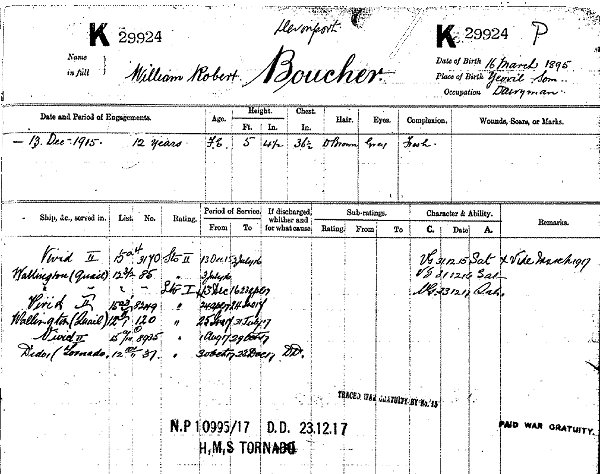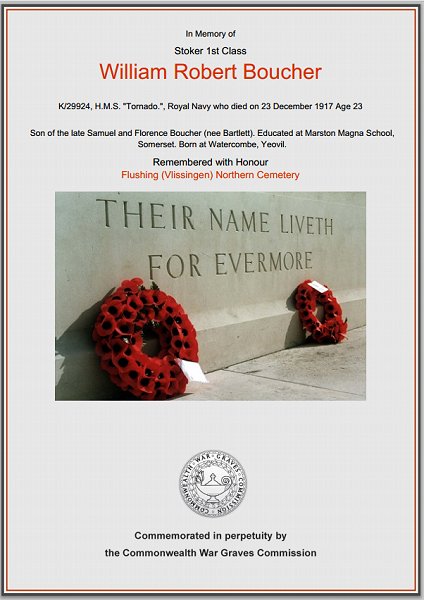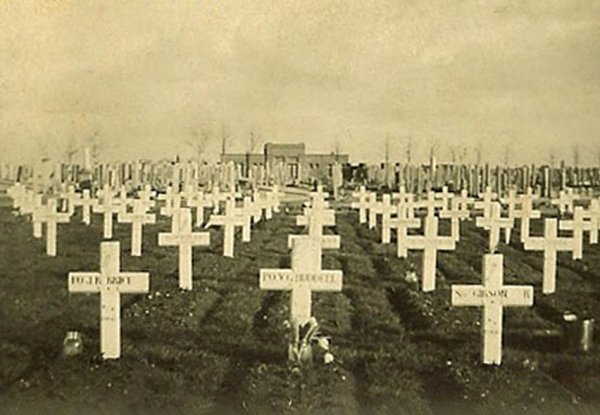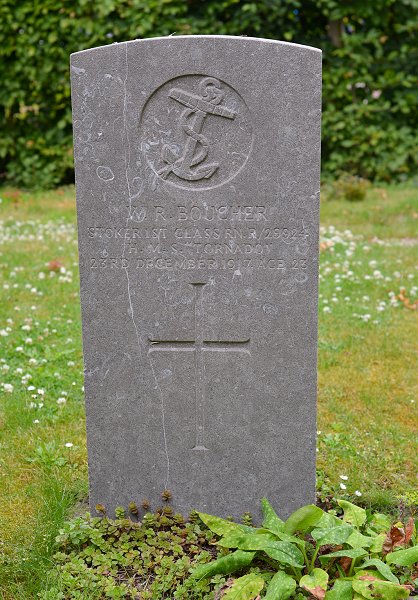yeovil at War
William Robert Boucher
Lost at sea when his ship hit a mine
William Robert Boucher was born on 16 March 1895 at Watercombe, Preston Plucknett, Yeovil, the son of cattleman Samuel Boucher (1868-1916), originally from East Coker. There is some little intrigue over his mother; the Commonwealth War Graves Commission records his mother as Florence, however most records seem to indicate his mother was Mary Ann née Eason originally of Mudford Sock. Indeed. the Royal Navy were to notify Mary of William's death in 1917, by which time she had been widowed and was living at Red Brick House, Rimpton. In any event Samuel and Mary were married in 1899 in Yeovil, clearly a few years after William's birth. Nevertheless in the 1901 census Samuel and Mary were living with their two sons Sidney, aged 11, and 7-year old William at Chapel Hayes, Mudford, where Samuel worked as a cattleman and Mary was employed milking cows. William went to school at Marston Magna, presumably walking the two miles to school each day.
By the time of the 1911 census the family had moved a couple of miles to Corton Denham, where Samuel gave his occupation as a cowman on a farm, Mary gave hers as a washer on a farm and William gave his occupation as a cowboy on a farm. There was no sign of Sidney and Samuel and Mary indicated on the census form that they had only ever had one child - another small mystery (although I'm pretty sure it's the same Samuel, Mary and William as the ages and places of birth for all three tie up in the different census returns).
 Fortunately
we have
William's
service record;
he enlisted on
13 December 1915
for a period of
12 years. His
service number
was K29924 and
he was described
as 5 feet 4½
inches tall with
a 36½
inch chest, dark
brown hair, grey
eyes and a fresh
complexion.
Fortunately
we have
William's
service record;
he enlisted on
13 December 1915
for a period of
12 years. His
service number
was K29924 and
he was described
as 5 feet 4½
inches tall with
a 36½
inch chest, dark
brown hair, grey
eyes and a fresh
complexion.
His initial service, commencing on 13 December 1915, was at Vivid II - HMS Vivid II was the name of the Royal Navy barracks at Devonport, where he remained until 2 July 1916 then transferring to Wallington (Quail).
Wallington was the Auxiliary Patrol base at Grimsby while the name Quail in parenthesis was the ship he actually served on. HMS Quail was a B-class torpedo boat destroyer of the British Royal Navy. She was launched by Laird Brothers, Birkenhead, on 24 September 1895 and served in home waters and the West Indies for several years. HMS Quail formed part of the Seventh Destroyer Flotilla based on the Humber on the outbreak of the First World War. William served on her as a Stoker Class II from 3 July until 23 April 1917, being promoted Stoker Class I on 13 December 1916.
He returned to Royal Navy barracks at Devonport, HMS Vivid II, on 24 April 1917 where he remained until 25 June at which time he returned to HMS Quail in Grimsby. He had a final stay at HMS Vivid II between 1 August and 29 October.
Throughout his service, at his annual reviews held in December of each year, his conduct was always rated very good and his ability rated as satisfactory. On 30 October 1917 he transferred to his new ship, HMS Tornado.
William's new ship, HMS Tornado, was indeed a new ship having been built in 1917 and only launched on 4 August 1917. She was an R Class Destroyer displacing 1,091 tons, 276 feet by 26 feet and armed with three 4" guns.
In late December 1917 eight Harwich Force destroyers, including Tornado, had been dispatched to escort a small convoy from the coast of Holland with the rendezvous off the Maas Light buoy. However, this was a regular occurrence and the procedure was known to the Flanders Flotilla of the German Navy. Around 10 December the Germans had laid a new minefield in the area off the North Sea coastline of Holland, an area close to the Maas Light buoy.
On 23 December 1917 the British R-Class destroyer Tornado, along with three other destroyers, Torrent, Surprise and Radiant, all brand new destroyers and the latest and very best in the Royal Navy, were steaming to meet the convoy but ran straight into the minefield. Torrent was hit first and started to sink. Surprise went to her rescue and suffered the same fate. Tornado tried in vain to get free from the minefield but tragically detonated two mines and immediately sank with only two survivors and losing the other 75 crew members, including William. Only a fourth destroyer, Radiant, managed to escape the carnage to return home safely. In all a total of 252 officers and men lost their lives.
William Boucher's body was washed ashore and buried in Flushing (Vlissingen) Northern Cemetery, Grave 1.15, in 1918. He was aged 23. However William is not commemorated on the Yeovil War Memorial in the Borough.
gallery

William Boucher's service record.

The Commonwealth War Graves Commission certificate in memory of William Boucher.

Flushing (Vlissingen) Northern Cemetery, photographed around 1920.

William Boucher's headstone.